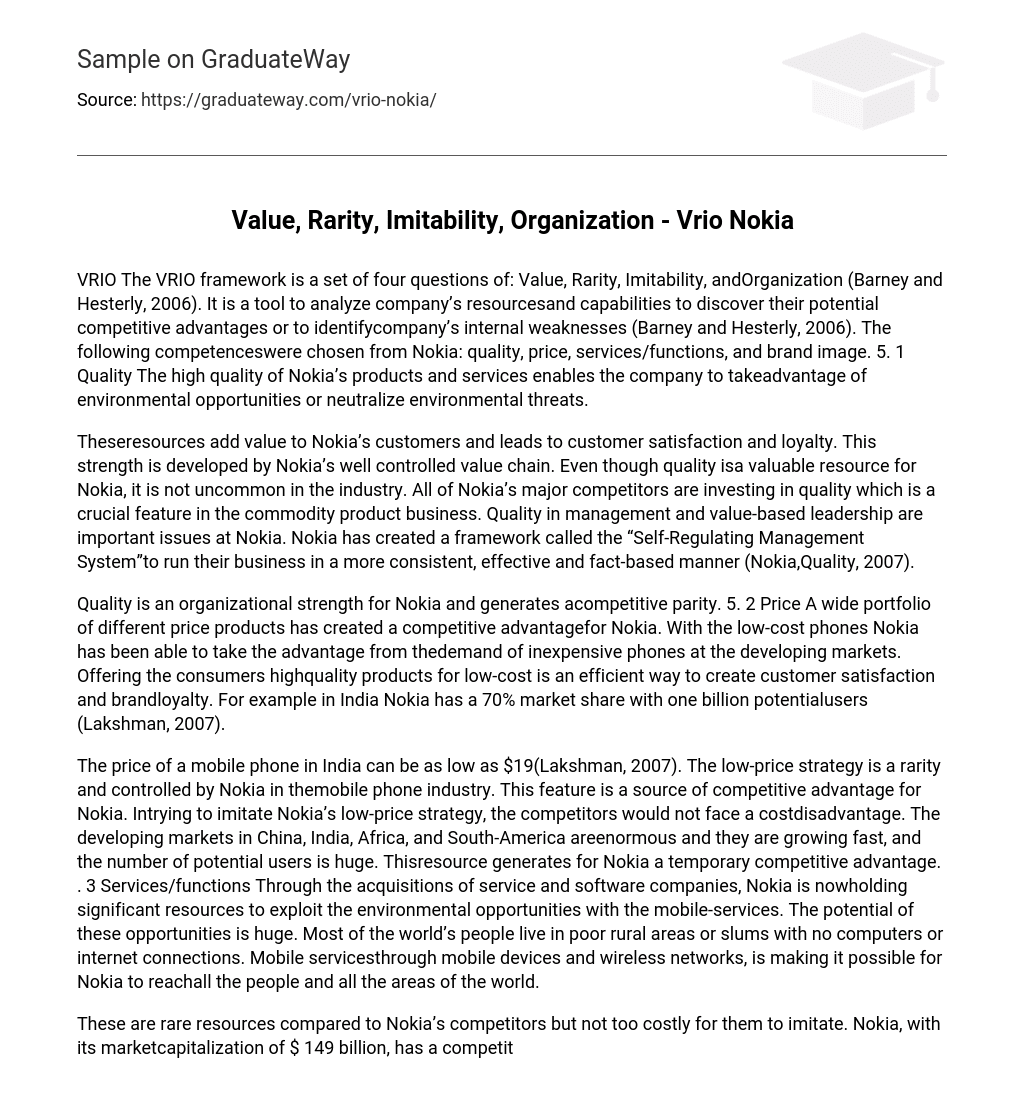VRIO The VRIO framework is a set of four questions of: Value, Rarity, Imitability, andOrganization (Barney and Hesterly, 2006). It is a tool to analyze company’s resourcesand capabilities to discover their potential competitive advantages or to identifycompany’s internal weaknesses (Barney and Hesterly, 2006). The following competenceswere chosen from Nokia: quality, price, services/functions, and brand image. 5. 1 Quality The high quality of Nokia’s products and services enables the company to takeadvantage of environmental opportunities or neutralize environmental threats.
Theseresources add value to Nokia’s customers and leads to customer satisfaction and loyalty. This strength is developed by Nokia’s well controlled value chain. Even though quality isa valuable resource for Nokia, it is not uncommon in the industry. All of Nokia’s major competitors are investing in quality which is a crucial feature in the commodity product business. Quality in management and value-based leadership are important issues at Nokia. Nokia has created a framework called the “Self-Regulating Management System”to run their business in a more consistent, effective and fact-based manner (Nokia,Quality, 2007).
Quality is an organizational strength for Nokia and generates acompetitive parity. 5. 2 Price A wide portfolio of different price products has created a competitive advantagefor Nokia. With the low-cost phones Nokia has been able to take the advantage from thedemand of inexpensive phones at the developing markets. Offering the consumers highquality products for low-cost is an efficient way to create customer satisfaction and brandloyalty. For example in India Nokia has a 70% market share with one billion potentialusers (Lakshman, 2007).
The price of a mobile phone in India can be as low as $19(Lakshman, 2007). The low-price strategy is a rarity and controlled by Nokia in themobile phone industry. This feature is a source of competitive advantage for Nokia. Intrying to imitate Nokia’s low-price strategy, the competitors would not face a costdisadvantage. The developing markets in China, India, Africa, and South-America areenormous and they are growing fast, and the number of potential users is huge. Thisresource generates for Nokia a temporary competitive advantage. . 3 Services/functions Through the acquisitions of service and software companies, Nokia is nowholding significant resources to exploit the environmental opportunities with the mobile-services. The potential of these opportunities is huge. Most of the world’s people live in poor rural areas or slums with no computers or internet connections. Mobile servicesthrough mobile devices and wireless networks, is making it possible for Nokia to reachall the people and all the areas of the world.
These are rare resources compared to Nokia’s competitors but not too costly for them to imitate. Nokia, with its marketcapitalization of $ 149 billion, has a competitive advantage over its competitors (Berman,Singer, 2007). This resource generates a temporary competitive advantage for the company 5. 4 Brand image One of Nokia’s most important resources is its strong brand image. The companyhas effectively been strengthening its brand image with efficient marketing campaigns.
Nokia is the world’s fifth most valuable brand with a brand value of $33,696 million asseen in figure 4 (Interbrand, 2007). It is the first non-US company in the ranking and theonly phone manufacturer in the top ten (Interbrand, 2007). Nokia was also the Asia’smost trusted brand in 2006 among 1,000 brands across 15 product and service categories(Datamonitor, 2007). A strong brand image is an extremely valuable resource for Nokiaand along its market leader position the company is able to compete effectively against itscompetitors.
This is a rare and imperfectly imitable resource. The competitors would facea huge cost disadvantage in trying to imitate this valuable resource. Nokia is very wellorganized to exploit the full potential of this resource. Nokia’s key quality targets, thatare the base of the company’s strong brand image, are; “For Nokia to be number one incustomer and consumer loyalty, number one in product leadership, number one inoperational excellence” (Nokia, Quality, 2007).
This resource is an organizationalstrength and generates a sustained competitive advantage for the company. As a conclusion Nokia has a wide variety of valuable resource that generates acompetitive advantage for the company as seen in table 1. These resources are results of effective organizational culture, innovativeness, and well organized efficient businessstrategies. Nokia observes the international market environment very intensively and isable to react to any changes in the markets extremely quickly due to its huge marketcapitalization.





